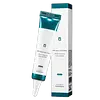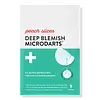What's inside
What's inside
 Key Ingredients
Key Ingredients

 Benefits
Benefits

 Concerns
Concerns

 Ingredients Side-by-side
Ingredients Side-by-side

Water
Skin ConditioningHippophae Rhamnoides Fruit Extract
Skin ConditioningPvp
Emulsion StabilisingAlcohol
AntimicrobialPolyvinyl Alcohol
Butylene Glycol
HumectantCentella Asiatica Extract
CleansingDryopteris Filix-Mas Root Extract
Skin ConditioningCurcuma Longa Root Extract
MaskingPortulaca Oleracea Extract
Skin ConditioningMelaleuca Alternifolia Leaf Extract
PerfumingMagnolia Kobus Bark Extract
Skin ConditioningDipotassium Glycyrrhizate
HumectantMelaleuca Alternifolia Leaf Oil
AntioxidantSalicylic Acid
MaskingAllantoin
Skin ConditioningSodium Polyacrylate
Absorbent1,2-Hexanediol
Skin ConditioningEthyl Hexanediol
SolventHexanediol
SolventPhytic Acid
Arginine
MaskingPhenoxyethanol
PreservativeDisodium EDTA
Polysorbate 80
EmulsifyingWater, Hippophae Rhamnoides Fruit Extract, Pvp, Alcohol, Polyvinyl Alcohol, Butylene Glycol, Centella Asiatica Extract, Dryopteris Filix-Mas Root Extract, Curcuma Longa Root Extract, Portulaca Oleracea Extract, Melaleuca Alternifolia Leaf Extract, Magnolia Kobus Bark Extract, Dipotassium Glycyrrhizate, Melaleuca Alternifolia Leaf Oil, Salicylic Acid, Allantoin, Sodium Polyacrylate, 1,2-Hexanediol, Ethyl Hexanediol, Hexanediol, Phytic Acid, Arginine, Phenoxyethanol, Disodium EDTA, Polysorbate 80
 Reviews
Reviews

Ingredients Explained
These ingredients are found in both products.
Ingredients higher up in an ingredient list are typically present in a larger amount.
1,2-Hexanediol is a synthetic liquid and another multi-functional powerhouse.
It is a:
- Humectant, drawing moisture into the skin
- Emollient, helping to soften skin
- Solvent, dispersing and stabilizing formulas
- Preservative booster, enhancing the antimicrobial activity of other preservatives
Butylene Glycol (or BG) is used within cosmetic products for a few different reasons:
Overall, Butylene Glycol is a safe and well-rounded ingredient that works well with other ingredients.
Though this ingredient works well with most skin types, some people with sensitive skin may experience a reaction such as allergic rashes, closed comedones, or itchiness.
Learn more about Butylene GlycolCentella Asiatica Extract (Centella) is derived from an herb native to Southeast Asia. It is famous for its anti-inflammatory and soothing properties.
Centella is rich in antioxidants and amino acids, such as Madecassic Acid and Asiaticoside.
Studies show the compounds in centella help with:
The combination of all these properties makes centella effective at soothing, hydrating, and protecting the skin.
Other great components of centella include Vitamin A, vitamin C, several B vitamins, and Asiatic Acid.
Fun fact: Centella has been used as a medicine and in food for many centuries. As a medicine, it is used to treat burns, scratches, and wounds.
Learn more about Centella Asiatica ExtractThis tea tree oil comes from the leaves of the Tea Tree plant. Tea tree oil has antioxidant, anti-inflammatory, and antimicrobial properties.
According to the book Journal of Profiles of Drug Substances, tea tree helps in reducing acne-causing bacteria such as Propionibacterium acnes. This is due to the Terpinen components of tea tree oil.
Tea tree may cause sensitivity and irritation for some people. This oil naturally contains fragrance such as linalool and limonene.
However, research shows irritation usually occurs when using pure tea tree oil and not in cosmetic products.
Tea tree oil was found to help relieve the symptoms of psoriasis in one study.
Tea tree oil is toxic when ingested. Another study showed it to caused damage to the nervous system of dogs and cats when applied to their skin or given orally.
Learn more about Melaleuca Alternifolia Leaf OilSalicylic Acid (also known as beta hydroxy acid or BHA) is a well-known ingredient for treating skin that struggles with acne and clogged pores. It exfoliates both the skin's surface and deep within the pores to help clear out buildup, control oil, and reduce inflammation.
Unlike AHAs (alpha hydroxy acids), salicylic acid is oil-soluble. This allows it to penetrate into pores which makes it especially effective for treating blackheads and preventing future breakouts.
Salicylic acid is also known for its soothing properties. It has a similar structure to aspirin and can calm inflamed or irritated skin, making it a good option for acne-prone skin that is also sensitive.
Concentrations of 0.5-2% are recognized by the U.S. FDA as an over-the-counter topical acne product.
It can cause irritation and/or dryness if one's skin already has a compromised moisture barrier, so it's best to focus on repairing that before introducing this ingredient into your routine.
While salicylic acid does not increase sun sensitivity, it’s still important to wear sunscreen daily to protect your skin.
If you are looking for the ingredient called BHA or Butylated Hydroxyanisole, click here.
Learn more about Salicylic AcidWater. It's the most common cosmetic ingredient of all. You'll usually see it at the top of ingredient lists, meaning that it makes up the largest part of the product.
So why is it so popular? Water most often acts as a solvent - this means that it helps dissolve other ingredients into the formulation.
You'll also recognize water as that liquid we all need to stay alive. If you see this, drink a glass of water. Stay hydrated!
Learn more about Water